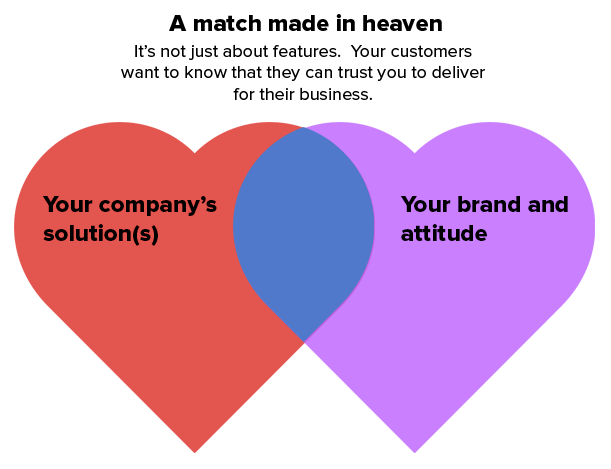Why converting customers is like dating: it takes time to earn trust
-
Data ManagementUpdatedPosted:
On this page
Have you ever been on a date with a stranger?
With Valentine’s Day having just passed most of us will have given some recent thought to our love lives. Those first dates are never easy, are they? You want to know whether your date is a match — do they like the same things? Is the conversation free flowing? Do you find them attractive? Should you call them again?
Choosing which product to buy can be an equally confusing process. When you hit a company’s landing page it can feel exactly like that first date. Does the site have the solution to match my needs? Do I like them? Does this feel right?
Sometimes the answer is an immediate and resounding yes but usually you’ll need some more time to be convinced, just like that first date.
As an online business owner you need to remember that not everyone is going to sign up for or buy your product immediately. Any number of factors could turn potential customers off and that kinda sucks, doesn’t it?
You’ve spent hours of your time, and thousands of dollars getting these customers to your site. You’ve blogged hard, you’ve bought ads, and you’ve formed partnerships with other companies, but none of it seems to pay off…
So what can you do to give yourself the best chance of converting these customers?
Sharing is caring … and, as it turns out, marketing!
When it comes to selling online, the most effective businesses realize that education is an extremely powerful and non-invasive form of ‘selling’.
Here are two reasons it works:
- It builds trust.
- It adds a human element.
What business owners often forget is that a big part of selling is simply getting your potential customers to ‘like’ you.
Why? Purchase decisions are about the total package: the look and feel of your product, the way you communicate and, ultimately, whether your potential buyers trust you. You’re not going to go on a second date with someone you don’t trust!
Likewise, why would you buy a product from someone you don’t trust?
The proof is in the pudding
The fact is, it is super hard to build trust from a simple landing page.
According to customer analytics service KISSmetrics, the average bounce-rate for a basic landing page is well above 50%, across all industries.
Further to this the average conversion rate on a landing page is generally anywhere from 2 and 20%.
The 80%+ of people leaving your site primarily do so for one of two reasons: they’ve decided your product isn’t for them or they aren’t invested enough to make a decision to buy.
It’s absolutely critical to harness every opportunity you have to convert each of those visitors.
Alright, I get it. Let’s do this!
Email is an extremely effective way of delivering a message to your customers.
This week we’re going to look at using a series of lifecycle emails to build trust and ultimately convert visitors into customers.
The educational series we’re going to set up is essentially a means of giving your customers a series of free ‘lessons’. Your email campaign shouldn’t hard sell your product.
Quite the opposite; you should give away as much possible.
Don’t make the mistake of talking about your product non-stop; you need to talk about your customers and their problems.
If you’re trying to convert a new, interested, lead into a buyer an ideal format is to send a series of 4-8 emails over a period of an initial 30 day period. You don’t want to be sending more than two emails a week and you want these emails to be chock-full of awesome, free secrets.
So: you’re going to create around 6 emails that aim to educate your new readers on their problem, the market and how they can solve these problems. You’re going to be doing it for free.
You don’t want to be sending more than two emails a week and you want to make these emails count.
Here are two great examples from growing businesses that use educational campaigns to convert customers.
WPEngine
Take the good folks at WPEngine. Their educational course covers (yes, you guessed it!) WordPress hosting and ways to make your blog faster.WPEngine basically gives away all the awesome stuff they do for their customers for free, via email. This is a great way to give you, the reader, a real taste of the service.
Patrick McKenzie, founder of Kalzumeus.com, dives into how effective this is for WPEngine but the fact is, by giving away all of these secrets WPEngine effectively convinces its readers (bloggers and website owners) how much of a hassle it truly is to maintain a fast WordPress blog. It’s a massive problem, a huge pain in the ass… and the solution is WPEngine.com!
NET-A-PORTER
The format is a little different but luxury online clothing retailer NET-A-PORTER nails educational content with its email campaigns.
They’ve recently released a weekly magazine, The Edit. Here’s an example:
This weekly Magazine, delivered via emails, isn’t just links to different items of clothing – they have stories and tid-bits teaching their customers the latest styles, trends and ways to wear fashion.
Now that’s pretty cool. Next time one of their readers needs to dress up, can you guess who they’ll be buying from?
eCommerce stores should take inspiration and put new customers on a drip sequence of emails like this that educate the customer about the products on offer: how can the customer make the most of your products? Consider this a great supplement, or even alternative, to the drab blast campaigns stores usually send out like crazy.
Why this works?
By now you should have a clear understanding of the impact an educational campaign can have.
You only need to write the content once and it can live for ever. Providing value over and over again to new potential customers. If you’re providing something that is useful and relevant, your subscribers will thank you, and some of them will become paying customers.
I remember Noah Kagan, founder of AppSumo, once saying he wanted to share so much stuff that customers would feel guilty if they didn’t buy from him. He still sends out a weekly email with hacks on marketing, self-improvement and startups. From time to time he might exaggerate a little for effect but his consistent sharing over the years has built a bond with partners and customers the world over.
If you share enough awesome stuff, then customers will want to buy from you!
Okay I’m convinced…but what can I share?
Creating some great content on the specific area of your product sounds extremely daunting, but it’s not!
Remember: you work on your business 24/7, 365 days a year and I guarantee you will know a heck of a lot more about it than 99% of people out there.
At Vero, I blog about email marketing, NET-A-PORTER writes about clothes, and over at WPEngine they’re all about WordPress. So, what can you write about?
The trick with email campaigns is to start writing. Give this stuff a go by starting small. I wrote the Vero email education campaign one post at a time, refining as I went along. Now we have a full series that anyone can subscribe to.
Let me explain how our education campaign works. Our campaign consists of seven emails over 31 days:
- Action Items For Improving Your Conversions Using Email
- Three Quick Wins To Improve Your Email Marketing Conversions
- The Email Copy That Increased Overall Sales by 10%
- How To Get Up And Running With Email Remarketing<– This is the first time I ‘sell’ customers on a Vero Free Trial. This email currently has the highest click through-to-open ratio. It must be working ;).
- The Remarketing Emails You MUST Be Testing
- How to setup a drip campaign, just like the one you’re reading!
- Email Elements You Should Be A/B Testing Today<– This is where I close out the course and mention our free trial once again.
A rule of thumb we’ve followed is to only sell at the halfway mark, and then again at the end. Use our series as a guide for your own educational campaign.
Our own success proves these campaigns works. Our educational course converts 8% of readers to free trials.
For us this is huge. It means that customers who would otherwise bounce from our blog or website come back and actually start a free trial. This effectively leverages our marketing spend and gives me something to dance about.
Not only is it a great lead generation tool, I also regularly get emails that say things like:
Thanks Chris, this is awesome content. I am loving it! Are you able to tell me a little more about XYZ?
Although many of these customers don’t sign up, I get real feedback, potential customers get to interact with me and we build our brand with each interaction.
Why wouldn’t you want each of these things? We also get better at providing helpful content, and the cycle goes on.
How do I get leads to my campaign?
Okay, so you’ve created the campaign and you’re all set to go, but there’s one important question remaining: how do you get people signing up for this awesome campaign you’ve created?
There are three approaches I’ve seen work wonders:
1. A dedicated landing page
A standard practice is to use a dedicated landing page as a way to entice customers to your educational campaign. It’s a method used by many of the experts on educational campaigns because it works. Generally you would offer your customers a clear benefit, such as an eBook or some other locked goodie. This tactic allows you to drive paid or free traffic from elsewhere.
Check out examples from Hubspot who have created a microsite for their course(s). Helpscout does the same.
2. Whack a call to action on your home page
HitTail takes a different approach, with a signup form for their campaign at the bottom of their homepage. They offer a free seven-part course on how to boost your SEO. We also had our campaign signup form on our homepage for a while, and found it to be effective.
The only thing to test here is whether a second call to action detracts from your signups. This can somewhat be mitigated using a delayed popup or a series of survey questions via Qualaroo’s new screens feature:
For example, if customers tell you they don’t understand your product or it’s value hit them with an invitation to learn more!
3. Remarketing
There are some great tools to get people coming back to your landing page. For starters, try Google Adwords, AdRoll and Perfect Audience. These tools are an awesome way to bring people back to a specific landing page.
Consider targeting blog readers or visitors who bounce from your site (i.e. do not purchase) and send them to your dedicates resources page where they can get educated.
Hop to it
You should be armed with a heap of ideas to test out after reading this post! If you have any questions about what to write in your educational emails, how to configure a landing page or just want a hand, write me an email as I’d be very happy to help!
Want to send more personalized mobile and email messages to your users?
Learn moreCustomer story

How UNO uses email marketing from the data warehouse to deliver personalized mortgage broking









